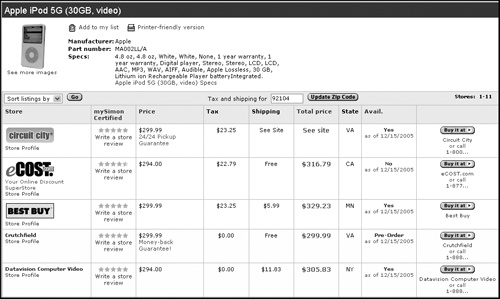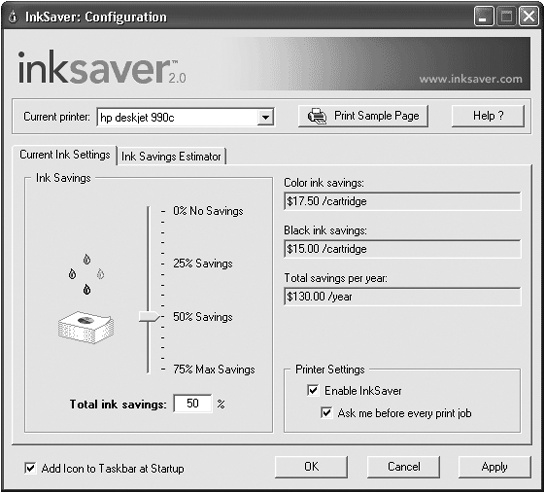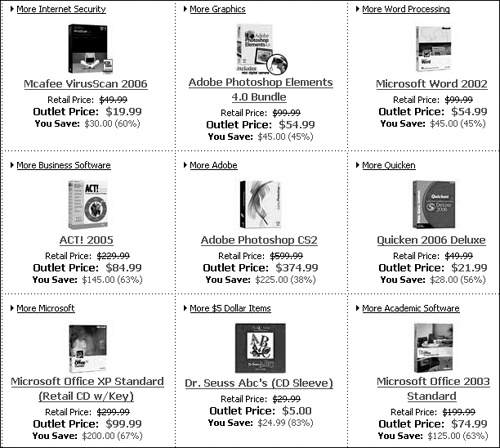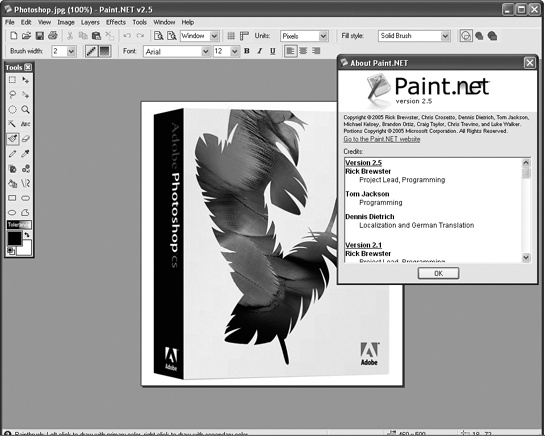Chapter 21. Computing on a Shoestring: Getting Stuff for (Almost) Free
The Internet may be changing the way people shop, learn, and communicate, but for those who don’t have a computer, it might as well be science fiction. With a little research and creativity, however, even the most cash-strapped would-be Internet surfer can get a computer and load it with software for nothing, or next to nothing.
Internet Comparison Shopping
Whether you want a new camera, computer, printer, scanner, or whatever, you should never pay full retail price for any high-tech or electronics product you find online. Before buying, shop around.
In the old days, shopping around meant driving countless hours to different stores to compare prices. Nowadays, by visiting the right shopping search engines, you can comparison shop among retailers all over the country without doing anything more exhausting than typing on a keyboard.
Shopping search engines, as shown in Figure 21-1, help you find the best price for a particular item and often include reviews of the product itself, evaluations of the retailer’s customer service, and a list of similar products you might want to consider instead. A low price might seem attractive, but if it’s coming from a retailer with a poor record for shipping products on time or responding to complaints of defective merchandise, you might want to take your business to a more confidence-inspiring merchant and pay a slightly higher price.
Some popular shopping search engines include Froogle (www.froogle.com), Kelkoo (www.kelkoo.co.uk), MSN Shopping (http://shopping.msn.com), and Yahoo Shopping (http://shopping.yahoo.com).
These shopping search engines compare prices for different products, but the order in which they list the retailers that match a query can be critical. The first five retailers listed in search results often get the most business, regardless of price. Knowing this, many retailers pay an additional fee to get listed at the top of the search results in the hopes of increasing potential sales. As an alternative, consider using PriceScan (www.pricescan.com), which refuses to accept fees to increase a retailer’s standing on its list of results.
To save even more money, visit Woot! (www.woot.com) or Specialoffers.com (www.specialoffers.com), which has updated information on the latest discounts and promotions currently being offered by various merchants.
When buying anything online, try to find other people’s comments about the seller. Sites like Amazon.com let buyers rate different merchants for speed, reliability, and dependability. If a merchant offers a low price but has a spotty record with other buyers, you may want to avoid that merchant and pay more from a more reliable merchant instead.
Buying a Refurbished Computer
Any of the shopping search engines listed in the Internet Comparison Shopping section will help you find the best prices for new computer equipment, but to save even more, consider buying a refurbished computer instead.
Refurbished computers are machines that someone returned either because of a defect or because they didn’t want it any longer even though it may have been working perfectly well. Once a manufacturer receives a returned computer, it’s torn apart, the components are tested, and then it’s reassembled to be just like new. There’s just one problem. Legally, manufacturers can’t sell a returned computer as new.
Since the manufacturer has already lost money accepting a returned computer for resale, they’ll reduce the price significantly just to get rid of it. If the computer were to fail a second time and force another customer to return it, the manufacturer would lose still more money fixing it again, so refurbished computers are often examined even more carefully than new ones are.
If you don’t mind getting a computer that someone else may have used already, a refurbished computer can be a great way to get a top-of-the-line machine without paying top-of-the-line prices. Refurbished computers come with the same technical support and warranty as their identical brand-new models, but with one major drawback. When you buy a refurbished computer, you can only buy what the manufacturer has in stock that day. If you want to customize your computer, you’ll probably have to splurge on something new or be prepared to buy the accessories you want and install them yourself.
You won’t find refurbished computers for sale at your favorite store, however. Most computer manufacturers only sell them on retail sites such as Amazon.com (www.amazon.com), Dell Computers (www.dell.com/factoryoutlet), Gateway (www.gateway.com), Overstock.com (www.overstock.com), PC Factory Outlet (www.pcfactoryoutlet.com), PC Nomad (www.pcnomad.com) and SonyStyle (www.sonystyle.com).
Note
Some people may use a computer and then return it later, which means a refurbished computer might still have someone else’s data on the hard disk that you can undelete and peek at. See Chapter 22 for more information about recovering deleted data.
Save on Printer Supplies
Almost everyone needs a printer, but watch out. Many printer manufacturers seduce you with low prices on their inkjet models only to gouge you on replacement ink cartridges. The cost of two or three ink cartridges can be as much as the original price of the printer itself, and inkjet printers tend to suck up ink rapidly.
A program dubbed Ink Saver (www.inksaver.com), shown in Figure 21-2, claims to reduce the amount of ink your printer uses without any noticeable difference in print quality. Ink Saver is compatible with most Epson, Canon, and Hewlett-Packard printers, but you can download a trial version to see if it works with your particular inkjet printer.
No matter how much ink a program like Ink Saver can help you conserve, you’ll eventually need to buy replacement inkjet cartridges. Instead of getting them from the printer manufacturer, buy refill kits or alternate inkjet cartridges from Amazon Imaging (www.amazonimaging.com) or RhinoTek (www.buyrhinotek.com). To find more online retailers that sell replacement inkjet, visit Buy Ink Cartridges.com (www.buyinkcartridges.com). These third-party inkjet companies sell refill kits and replacement cartridges for most printers at up to half of what the original manufacturers would charge for the exact same thing.
If you’re shopping for an inkjet printer, compare the prices of replacement cartridges first. The printer that looks so appealing today might wind up costing you several hundred dollars in the future for replacement inkjet cartridges alone. Look for the cheapest cartridges and then find the printers that work with them.
To foil the companies that offer cheap replacement cartridges, printer manufacturers have come up with several tactics to force consumers to buy inkjet cartridges only from them. Hewlett-Packard puts computer chips in inkjet cartridges to prevent them from being refilled. The moment a cartridge runs out of ink, the chip prevents it from ever being used again, no matter how much you refill it with replacement ink, although you can buy new chips from SmartChipSolutions (www.smartchipsolutions.com) to trick your printer into accepting a third-party replacement ink cartridge. However, Lexmark and Hewlett-Packard have also even patented the print heads on certain inkjet cartridges, thereby preventing anyone from making a compatible replacement cartridge. If you can’t find a replacement inkjet cartridge for your printer from a third party, now you know why.
If you have a laser printer, don’t throw away your old toner cartridges. Check your local Yellow Pages under computer supplies and look for stores (or contact Amazon Imaging) that refill or sell used cartridges for your particular model.
Free (and Almost-Free) Software
The two main types of software available are commercial and open source. Commercial software costs money, although in the case of shareware or adware-sponsored programs, that cost may be minimal. Open-source software is free. You can copy open-source programs as many times as you wish and even modify them, if you know what you’re doing. In many cases, open-source programs rival the features of their commercial counterparts, but don’t overlook commercial programs completely. There are ways of getting commercial software much cheaper than you might think.
Getting commercial software cheaply (and legally)
It’s easy to pirate software (see Chapter 6), but it’s not a practical (or legal) option for most people. Before you buy anything, try one of the following methods to get that same program for free or at a lower cost.
Bundled software
Many hardware manufacturers bundle “free” software with their products to entice customers. Most computers come with a preloaded operating system (such as Windows XP) but many companies include additional software too. For example, Sony computers often include digital video software, while other computer manufacturers offer WordPerfect or Microsoft Works with their systems.
Similarly, scanner companies typically bundle graphics editing programs or optical character recognition software, external hard disk manufacturers offer free backup software, and rewritable CD/DVD drives often include disk-burning programs. Bundled software is often a scaled-down or older version of a current application program, but if it’s got the features you need, a bundling deal could convince you to buy one manufacturer’s equipment over another.
Buying obsolete software, upgrades, and OEM versions
Bundled software can be valuable because it gives you the legal right to purchase an upgrade, which means that, for a minimal cost, you can buy the full version of a program without paying the full cost of a new version. If you don’t have any older software bundled with your computer equipment, you can often buy it at deeply discounted prices through online retailers such as Oldsoftware.com (www.oldsoftware.com), Software & Stuff (www.softwareandstuff.com), DirectDeals (www.directdeals.com), and Software Outlet (www.softwareoutlet.com).
Older software can work perfectly well while saving you up to 90 percent off the retail cost of the latest version. If you still want the newest version, buy an older one and then pay for the upgrade. The total cost for the older version, plus the upgrade, will almost always be less than you would’ve paid to get the full version right off the bat.
Another way to get the latest version of a program is to buy the original equipment manufacturer (OEM) version. Many software publishers bundle their latest programs with a variety of hardware, but you can find online retailers selling these OEM versions separately. An OEM program is identical to the retail package but without the fancy box and sometimes without the (nearly useless) printed manual. Figure 21-3 shows the price savings you can enjoy on OEM versions of some popular programs.
Buying software at academic discounts
School bookstores usually sell academic versions of nearly all major software at a substantial discount because software publishers want to get students hooked on using their products instead of a competitor’s. So a program that normally costs $495 might be sold at a university bookstore for $100.
Of course, the catch is that you must have a valid student ID to take advantage of offers from a university bookstore. If you know someone currently in college, ask him to buy the software for you (and in exchange, you can buy him beer). As another alternative, just sign up for one class, get your student ID, and use your student ID to buy all the software you want at academic discounts.
Shareware and freeware
Shareware programs let you freely copy and use a program for a trial period, usually 30 days, after which it may stop working unless you pay up. Surprisingly, shareware programs are often just as good (or even better) than their higher-priced, brand-name counterparts, and no matter what type of a program you need (virus scanner, word processor, paint program, and so on), you can almost always find a good shareware version.
Freeware programs are given away—you can legally use and own them without ever paying. Some freeware is software that has been abandoned by its manufacturer or is a scaled-down version of a program that’s intended to help market the commercial version. The idea is that if you like the freeware version, you might want to upgrade to the commercial version later to get more features. To find great collections of freeware and shareware, visit Simtel (www.simtel.net), Shareware.com (www.shareware.com), Tucows (www.tucows.com), SnapFiles (www.snapfiles.com), ZDNet Downloads (http://downloads-zdnet.com.com), SoftwareArchives (www.softwarearchives.com), or Jumbo (www.jumbo.com).
Name-brand alternatives
Commercial software often has the backing of a big company that can afford to support and upgrade its products on a regular basis. For that reason, many customers, especially businesses, prefer the security of having someone they can call for help (or someone they can blame).
When evaluating commercial software, it’s often cheaper to avoid the most popular programs and use a lesser-known but equally competent rival program instead. For example, the retail price for the standard edition of Microsoft Office is $399, but consider any of the following less expensive alternatives: WordPerfect Suite ($299)—www.corel.com, StarOffice ($69.95)—www.sun.com, or ThinkFree Office ($49.95)—www.thinkfree.com.
Or how about this. The full retail price for Photoshop is $649, but look at these less expensive alternatives: Photoshop Elements ($99.95)—www.adobe.com—or Corel Paint Shop Pro ($129)—www.corel.com.
Lower-cost name-brand alternatives may not offer all the features of a more established program, but they do offer almost perfect compatibility with those expensive programs’ file formats. If you don’t absolutely need Microsoft Word, for example, why waste your money paying for it?
Finding an open-source program
Open-source programs are not only free to use and copy; they’re also free to modify however you wish. Perhaps the best-known open-source program is the Linux operating system, which rivals the features of Microsoft Windows but with better reliability and security. Since anyone can modify an open-source program, many companies offer slightly different versions of Linux, known as Linux distributions. You can either buy a Linux distribution or download a copy for free off the Internet. Some popular Linux distributions include Red Hat Software (www.redhat.com), Mandriva Linux (wwwnew.mandriva.com/en/community), Debian (www.debian.org), Ubuntu Linux (www.ubuntulinux.org), and SUSE Linux (www.opensuse.org). There are literally hundreds of different Linux distributions available, in addition to the handful listed above, so if you want to explore more options, visit DistroWatch (http://distrowatch.com).
If you don’t have the time or patience to download a copy of Linux, and you don’t want to buy the full-price, boxed retail version from a store, you can order Linux CDs from Cheapbytes.com (www.cheapbytes.com). Cheapbytes just sells the discs, without the fancy retail box or any manuals, but you’ll save up to 90 percent off retail while still getting the latest Linux distribution.
For true computer renegades, skip both Microsoft Windows and Linux and go for a pure Unix environment in the form of FreeBSD (www.freebsd.org) or OpenBSD (www.openbsd.org). Linux, FreeBSD, and OpenBSD are more suitable for people unafraid of digging into the guts of their operating system and typing cryptic commands. If this doesn’t describe you, you may want to stick with friendlier operating systems, like Windows or Mac OS X.
Besides Linux, another popular open-source program is the OpenOffice.org office suite (www.openoffice.org). OpenOffice.org essentially duplicates the applications and features of the Microsoft Office suite, but it’s absolutely free to copy, give away, and use. (OpenOffice.org is actually the free version of StarOffice, so using OpenOffice.org is like using a commercial program but without the cost.)
Two popular open-source programs that rival Photoshop include GIMP (GNU Image Manipulation Program)—www.gimp.org—and Paint.NET (www.eecs.wsu.edu/paint.net), which is shown in Figure 21-4.
To find more open-source programs, visit SourceForge (http://sourceforge.net). Not only can you download additional open-source programs, but you can also contribute to existing open-source projects or launch your own open-source program.
Free Internet Access
Network television is free because advertisers cover the costs of producing the shows in return for the opportunity to market their products to a vast audience. Similarly, many Internet providers now offer free accounts if you’ll agree to allow them to place advertisements on your computer screen or to track your online usage for marketing purposes. Many of these services have limitations or restrictions that change over time, so read their descriptions carefully.
For example, two popular Internet service providers, Juno (http://www.juno.com) and NetZero (http://www.netzero.net), both restrict customers’ free usage to a maximum of ten hours per month. To find the latest free Internet service providers, visit the Internet 4 Free website (www.internet4free.net).
If you don’t have your own computer or Internet connection, most public libraries have computers connected to the Internet. You probably won’t have to pay for online access, but there could be a time limit for using the terminal and a fee if you need to print anything.
Free Email Accounts
Free email accounts are perfect if you need to send messages that you don’t want traced back to you personally. They’re also handy for creating temporary email addresses that you can use when registering at different websites, knowing that this registration will inevitably attract spam, thus keeping your personal or work email account spam-free.
Many free email accounts offer special features including encryption (to protect your email from prying eyes), a self-destruct capability (to wipe out your email after a specified period of time), support for multiple languages, and anonymity (to hide your true identity from the rest of the world). Some popular free email account providers include Hotmail (www.hotmail.com), Yahoo! Mail (http://mail.yahoo.com), anonMail (www.anonmail.de), Hushmail (www.hushmail.com), and myTrashMail (www.mytrashmail.com).
Free Web and Blog Space
Many online services and Internet providers give you several megabytes of storage space so that you can start your own website. Unfortunately, the amount of space available may be too small for you to get as creative as you want, or the Internet provider may censor the information you post. For example, America Online tends to frown on anyone using its service to post anti–America Online comments.
If the rules or storage space of your current Internet provider aren’t satisfactory, try one of the many companies that offer free websites. These companies usually don’t care what type of information you post—all they really care about is attracting people to their own website so they can sell ads. Some popular free web hosting services include Geocities (http://geocities.yahoo.com), Tripod (www.tripod.lycos.com), AngelFire (www.angelfire.lycos.com), and Zero Catch (www.0catch.com).
If you want to experiment for free with blogging, try Blogthing (www.blogthing.com), Blogfuse (www.blogfuse.com), or Blogger (www.blogger.com), as shown in Figure 21-5.
The Best Things in Life Are Free
For more free stuff, visit The Free Site (www.thefreesite.com), the Free Stuff Center (www.freestuffcenter.com), or Totally Free Stuff (www.totallyfreestuff.com) and get everything from free ring tones to free postcards, and even free condoms, to go along with the free software, free printer supplies, and free email accounts that you want.
Although the cost of computers can widen the gap between the haves and the have-nots, it doesn’t have to be this way. With a little creativity and a lot of persistence, anyone can access the Internet. And who knows? With access to the Internet, you might one day help change political policy, meet new friends, or just broaden your mind by exploring the whole world from the comfort of your home—all without going bankrupt buying lots of expensive computer equipment, software, and services that you don’t really need.





